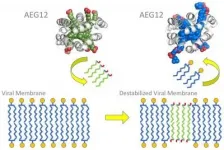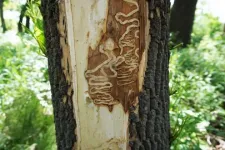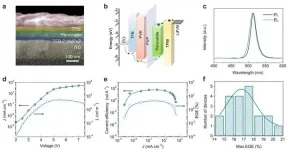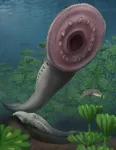(Press-News.org) The mosquito protein AEG12 strongly inhibits the family of viruses that cause yellow fever, dengue, West Nile, and Zika and weakly inhibits coronaviruses, according to scientists at the National Institutes of Health (NIH) and their collaborators. The researchers found that AEG12 works by destabilizing the viral envelope, breaking its protective covering. Although the protein does not affect viruses that do not have an envelope, such as those that cause pink eye and bladder infections, the findings could lead to therapeutics against viruses that affect millions of people around the world. The research was published online in PNAS.
Scientists at the National Institute of Environmental Health Sciences (NIEHS), part of NIH, used X-ray crystallography to solve the structure of AEG12. Senior author Geoffrey Mueller, Ph.D., head of the NIEHS Nuclear Magnetic Resonance Group, said at the molecular level, AEG12 rips out the lipids, or the fat-like portions of the membrane that hold the virus together.
"It is as if AEG12 is hungry for the lipids that are in the virus membrane, so it gets rid of some of the lipids it has and exchanges them for the ones it really prefers," Mueller said. "The protein has high affinity for viral lipids and steals them from the virus."
As a result, Mueller says the AEG12 protein has great killing power over some viruses. While the researchers demonstrated that AEG12 was most effective against flaviviruses, the family of viruses to which Zika, West Nile, and others belong, it is possible AEG12 could be effective against SARS-CoV-2, the coronavirus that causes COVID-19. But, Mueller said it will take years of bioengineering to make AEG12 a viable therapy for COVID-19. Part of the problem is AEG12 also breaks opens red blood cells, so researchers will have to identify compounds that will make the protein target viruses only.
Alexander Foo, Ph.D., an NIEHS visiting fellow and lead author of the paper, explained that mosquitoes produce AEG12 when they take a blood meal or become infected with flaviviruses. Like humans, mosquitoes mount a vigorous immune response against these viruses, with AEG12 bursting their viral covering. But, at the beginning of the project, Foo and his colleagues knew little about the function of AEG12.
"The prospect of studying a new protein is exciting, yet daunting," Foo said. "Thankfully, we had enough clues and access to a wide range of expertise at NIEHS to piece it together."
Co-author and crystallography expert Lars Pedersen, Ph.D., is leader of the NIEHS Structure Function Group. He routinely uses information about a molecule's physical makeup in his work and encourages more scientists to consider using this data in their studies. He said, "Our research shows that understanding the structure of a protein can be important in figuring out what it does and how it could help treat disease."
INFORMATION:
About the National Institute of Environmental Health Sciences (NIEHS): NIEHS supports research to understand the effects of the environment on human health and is part of the National Institutes of Health. For more information on NIEHS or environmental health topics, visit http://www.niehs.nih.gov or subscribe to a news list.
About the National Institutes of Health (NIH): NIH, the nation's medical research agency, includes 27 Institutes and Centers and is a component of the U.S. Department of Health and Human Services. NIH is the primary federal agency conducting and supporting basic, clinical, and translational medical research, and is investigating the causes, treatments, and cures for both common and rare diseases. For more information about NIH and its programs, visit http://www.nih.gov.
NIH...Turning Discovery Into Health®
Grant Numbers:
Z01ES043010
ZICES102506
ZIAES102645
Reference: Foo ACY, Thompson PM, Chen S-H, Jadi R, Lupo B, DeRose EF, Arora S, Placentra VC, Premkumar L, Perera L, Pedersen LC, Martin N, Mueller GA. 2021. The mosquito protein AEG12 displays both cytolytic and antiviral properties via a common lipid transfer mechanism. Proc Natl Acad Sci U S A: doi: 10.1073/pnas.2019251118 [Online 9 March 2021].
Contact:
Robin Arnette
301-642-9910
arnetter@niehs.nih.gov
Throughout history, leather has been a popular material for clothes and many other goods. However, the tanning process and use of livestock mean that it has a large environmental footprint, leading consumers and manufacturers alike to seek out alternatives. An article in Chemical & Engineering News (C&EN), the weekly newsmagazine of the American Chemical Society, details how sustainable materials are giving traditional leather a run for its money.
Traditional leather goods are known for their durability, flexibility and attractive finish, with a global market worth billions, writes ...
Since its introduction, the emerald ash borer (EAB) has become the most devastating invasive forest insect in the United States, killing hundreds of millions of ash trees at a cost of hundreds of millions of dollars.
Now, new research from the University of Minnesota's Minnesota Invasive Terrestrial Plants and Pests Center (MITPPC) shows a possible path forward in controlling the invasive pest that threatens Minnesota's nearly one billion ash trees.
In a recent study published in Fungal Biology, MITPPC researchers identified various fungi living in EAB-infested trees -- a critical ...
Energy-efficient light-emitting diodes (LEDs) have been used in our everyday life for many decades. But the quest for better LEDs, offering both lower costs and brighter colours, has recently drawn scientists to a material called perovskite. A recent joint-research project co-led by the scientist from City University of Hong Kong (CityU) has now developed a 2D perovskite material for the most efficient LEDs.
From household lighting to mobile phone displays, from pinpoint lighting needed for endoscopy procedures to light source to grow vegetables in Space, LEDs ...
Hip fractures are serious, especially for the elderly. The operation can be a great strain, and 13 per cent of patients over the age of 70 do not survive 60 days after the fracture.
Their chance of survival may depend on how busy the surgeons are with other emergency procedures.
"When the operating room is busy, 20 per cent more of the patients die within 60 days after the operation," says Professor Johan Håkon Bjørngaard at the Norwegian University of Science and Technology's (NTNU) Department of Public Health and Nursing.
Surgeons can get especially busy during periods when the patient demand for surgery is high. In busy periods, hip fracture patients ...
Bone is not just a fixed material - it's a dynamic set of structures that can adapt their mass and strength based on the loads they must support.
Developing that sort of adaptive material has long been the dream of scientists. Now for the first time, scientists at the Pritzker School of Molecular Engineering (PME) at the University of Chicago have developed a gel material that strengthens when exposed to vibration.
Not only were scientists able to make the material 66 times stronger through vibrations, they were also able to strengthen only the areas exposed to movement. That sort of specificity could lead to new adhesives and ...
Scientists have developed a see-through glass display with a high white light contrast ratio that smoothly transitions between a broad spectrum of colors when electrically charged. The technology, from researchers at Jilin University in Changchun, China, overcomes limitations of existing electrochromic devices by harnessing interactions between metal ions and ligands, opening the door for numerous future applications. The work appears March 10 in the journal Chem.
"We believe that the method behind this see-through, non-emissive display may accelerate the development of transparent, eye-friendly displays with improved readability for bright working conditions," says Yu-Mo Zhang, an associate professor of chemistry at Jilin ...
The cryptocurrency market has been abuzz as Bitcoin gains popularity with investors, reaching an all-time high of over $58,000 apiece in February. In a commentary published March 10 in the journal Joule, financial economist Alex de Vries quantifies how the surging Bitcoin price is driving increasing energy consumption, exacerbating the global shortage of chips, and even threatening international safety.
Theoretically, any computer with access to the internet and electricity can "mine" Bitcoin, a process to receive cryptocurrency by solving sophisticated mathematical equations. It is estimated that all miners combined make over 150 quintillion--that is 18 zeros following 150--attempts every second to solve the equation, according to numbers from January 11, 2021. Computational power ...
Scientists and healthcare providers are beginning to use a new approach for assessing a person's inherited risk for diseases like Type 2 diabetes, coronary heart disease and breast cancer, which involves calculating a END ...
When we think about the causes of neurological disorders and how to treat them, we think about targeting the brain. But is this the best or only way? Maybe not. New research by scientists at Baylor College of Medicine suggests that microbes in the gut may contribute to certain symptoms associated with complex neurological disorders. The findings, published in the journal Cell, also suggest that microbe-inspired therapies may one day help to treat them.
Dr. Mauro Costa-Mattioli, professor and Cullen Foundation Endowed Chair in neuroscience and director of the Memory and Brain Research Center at Baylor, discovered ...
Ottawa, March 10, 2021 - A new study of fossilized lampreys dating from more than 300 million years ago is challenging a long-held theory about the evolutionary origin of vertebrates (all animals with a backbone). The findings are published March 10 in the science journal Nature.
Lampreys are ancient, jawless, eel-like fishes that arose around half a billion years ago and they have long provided insights into vertebrate evolution. Now, scientists with the Canadian Museum of Nature, the University of Chicago and the Albany Museum in South Africa are reporting their analysis of dozens of tiny fossils that track the life stages and growth of ancient lampreys, from hatchlings to juveniles to adults.
Their results counter the established view that the blind, filter-feeding ...




